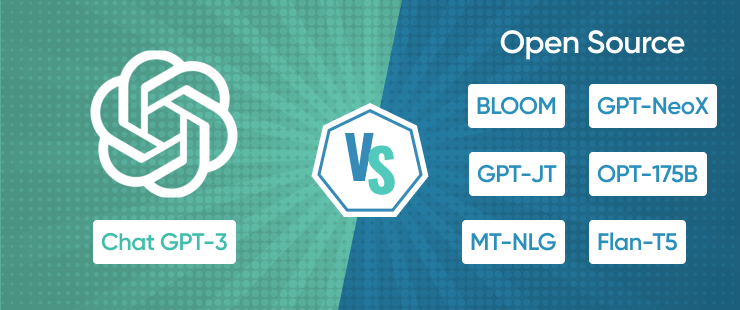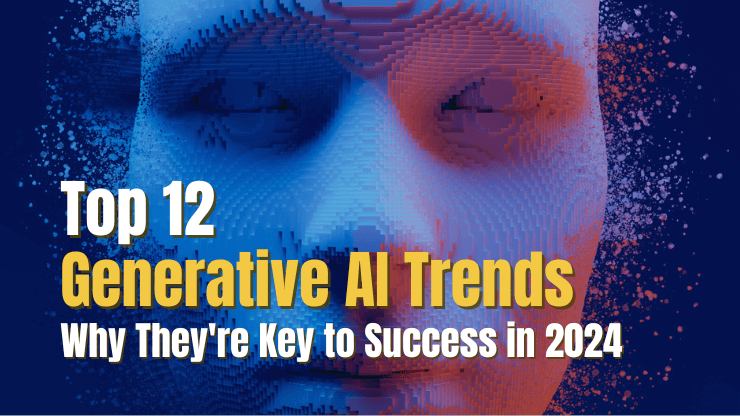With the recent breakthroughs in natural language processing, OpenAI's GPT-3 has emerged as the go-to model for natural language generation. Its advanced capabilities have enabled companies to generate content quickly and accurately, yet its closed-source codebase has made it difficult to use for independent researchers and companies who require complete flexibility.
But now there are a number of open-source alternatives to GPT-3 that are proving to be just as powerful for businesses and researchers alike. In this article, we will look at:
- The benefits and limitations of using GPT-3
- GPT-3 open source alternatives in 2023
- How to test open source models
So if you're looking for an open source alternative to GPT-3, this article will help you make an informed decision. Let's get started!
What is GPT-3
GPT-3 is short for generative pre-trained transformer 3 and is an unsupervised language model developed by OpenAI. At the time it launched in 2020, GPT-3 was the largest language model ever created, containing over 175 billion parameters.
GPT-3 and open source large scale language models make use of a massive amount of training data to produce human-like text and complete tasks like answering questions, summarizing documents, and translating languages without any further training required.
In 2023 German Max Planck Institute conducted a study to compare the cognitive abilities of humans and GPT-3 using canonical psychological tests to compare their skills in decision-making, information search, and cause-and-effect relationships. The results of the study are amazing:
- AI can solve problems and make decisions based on descriptions as well as or better than humans
- AI is not just at the level of people but even makes the same mistakes that are common to people
But in two cognitive abilities, AI falls short of humans:
- When searching for information, GPT-3 does not show signs of directed research
- In cause-and-effect problems, GPT-3 is at the level of a young child
The authors believe that in order to catch up with humans on these two abilities, AI must actively communicate with humans. It’s not hard to imagine this hurdle being overcome quickly with millions of people already communicating with ChatGPT.
Benefits of GPT-3
The launch of OpenAI’s GPT-3 was a milestone in the development of natural language AI systems. For the first time, an AI model was able to formulate short texts in such a believable and coherent way that they could no longer be recognized by humans as AI-generated. Subsequently, the model proved flexible for many other applications, such as generating code that only required minor fine-tuning.
Since launch, the GPT-3 series of models has expanded to include conversational AI models like ChatGPT and more powerful models such as DaVinci which provide:
- Increased long-form quality: The GPT-3 DaVinci model has been designed to provide more high-quality long-form responses that are more natural and nuanced than previous models.
- Increased scalability: GPT-3 DaVinci is able to scale to larger datasets and larger training models, enabling it to handle more complex tasks.
- Improved language understanding: GPT-3 DaVinci is able to understand natural language better than previous models, allowing it to produce more accurate results.
Limitations of using GPT-3
While GPT-3 offers a compelling set of benefits, it does have limitations that are important to consider when making a technology decision for your business:
- Poor security: Because OpenAI does not provide visibility into their model and training data, some businesses are concerned about how their data is being processed and stored. Open source alternatives may provide better security options to businesses who need to protect sensitive data.
- Limited customization: GPT-3 may not provide the level of customization that some users need. If a high level of customization is required, teams may need to use other open source options that they can build solutions on top of.
- Limited access: Details about GPT-3’s model, including information about the training data are not made available to big tech companies or researchers. If this is key for your use case, you’ll certainly want to look at other options.
GPT3 Open Source Alternatives

In recent years, independent researchers have been striving to make large-scale language models more accessible to the public by developing open-source alternatives to AI models like OpenAI's GPT-3 and Google's LaMDA which are typically closely guarded. By doing so, these researchers hope to encourage further research and development in this area and provide the public with unrestricted, free access to this artificial intelligence technology.
Pioneers include the research collective EleutherAI and BigScience. Today even giants like Google, Meta and Microsoft have started to provide public access to their models. Let's look at the top GPT-3 open source alternatives:
BLOOM
BigScience Bloom is a true open-source alternative to GPT-3, with full access freely available for research projects and enterprise purposes.
The Bloom language model was trained with 176 billion parameters over 117 days at the supercomputing center of the French National Center for Scientific Research. The development was organized by the BigScience project, coordinated by Hugging Face, co-funded by the French government and involved over 1000 volunteer researchers.
BLOOM vs GTP-3:
- Bloom is focused on providing a multilingual AI model, and it has the ability to generate text in 46 languages and 13 programming languages. While OpenAI can provide responses in multiple languages, it has primarily been trained using English content.
- Bloom was only trained on text generation tasks, so it has a limited ability to support requests outside of that. On the other hand, GPT-3 was developed to complete a wide range of tasks such as writing programming code.
- Because Bloom is an open source AI, researchers can download it for free on Hugging Face. GPT-3 is available via OpenAI’s API with very limited, full access provided to only a very select few companies.
GPT-JT
GPT-JT is a decentralized language model developed by the Together community, including researchers from ETH Zurich and Stanford University. It builds on EleutherAI's six billion parameter GPT-J-6B, and has been fine-tuned with 3.5 billion tokens. GPT-JT is designed to be used with slower data centers with up to one gigabit/s available, and has the potential to achieve the same performance as GPT-3 in large language models.
Jack Clark, author of the Import AI newsletter, purports that GPT-JT could prove to be the end of an era of AI development that is solely driven by groups with access to large, centralized computer networks. He purported that “GPT-JT suggests a radically different future – distributed collectives can instead pool computers over crappy internet links and train models together.”
GPT-JT vs GPT-3:
- GPT-3 has almost 30 times as many parameters as GPT-JT, with 175 billion, yet GPT-JT still ranks second in the RAFT Score for holistic language model evaluation.
- GPT-JT uses a distributed infrastructure by splitting up tasks into small chunks and distributing them across multiple nodes in a network, which helps to reduce latency and maximize scalability. Compared to GPT-3, this makes it much easier for groups to access, utilize, and extend it who may not have access to large, centralized computer networks.
GPT-NeoX
GPT-NeoX (or also called GPT-NeoX-20B) is one of the most advanced open-source, natural language processing (NLP) models available. This 20-billion parameter autoregressive language model was developed by a collective of researchers from EleutherAI and trained on the “Pile.”
It built on previous, smaller versions of the model, such as GPT-J6B and GPT-Neo. GPT-NeoX-20B uses a different tokenizer than the one used in GPT-J-6B and GPT-Neo, which allocates additional tokens to whitespace characters, making the model more suitable for certain tasks like code generation.
GPT-NeoX vs GTP-3:
- According to Max Woolf, the GPT-J open source model is better at code generation than GPT-3. Note that these tests were from the middle of 2021, and GPT-3 Davinci was not available then. GPT-3 Davinci may now rival or exceed the performance of GPT-J. Woolf also saw similar results for Python code-generation.
- While GPT-3 can be used for both research and production, EleutherAI recommends using GPT-NeoX only for research purposes.
Read more:
Megatron-Turing Natural Language Generation (MT-NLG)
MT-NLG is the largest and most powerful monolithic transformer English language model available. This large language model was developed by NVIDIA in collaboration with Microsoft and has over 530 billion parameters, triple the size of OpenAI’s GPT-3.
As the successor to Turing NLG 17B and Megatron-LM, MT-NLG is capable of performing natural language tasks with greater accuracy, such as prediction, reading comprehension, common sense reasoning, natural language reasoning, and word meaning disambiguation. It has been trained with the help of the Selene supercomputer and its 560 A100 servers. This model is further improved by the use of mixed-precision training and HDR InfiniBand with full-fat tree extension.
MT-NLG vs GPT-3:
- MT-NLG was trained using the Pile and has 3 times more parameters than OpenAI’s GPT-3.
- Researchers must apply to get access to MT-NLG’s API. GPT-3’s model is abstracted and available to anyone via API.
Read more:
OPT-175B
OPT-175B is a language model developed by Meta with 175 billion parameters trained on publicly available data sets. It is designed for community engagement and research use cases, and is released under a noncommercial license. It is designed to be more energy efficient than GPT-3, consuming only 1/7th the carbon footprint.
OPT-175B is trained using Meta’s open source Fully Sharded Data Parallel (FSDP) API and NVIDIA’s tensor parallel abstraction within Megatron-LM to enable optimal training efficiency.
OPT vs GPT-3:
- OPT-175B has a higher utilization rate of ~147 TFLOP/s/GPU on NVIDIA’s 80 GB A100 GPUs, compared to GPT-3 which has a utilization rate of roughly 130 TFLOP/s/GPU
- OPT-175B is distributed under a noncommercial license, while GPT-3 is distributed under a commercial license
- OPT AI performs similarly to GPT-3 but with only 1/7th the carbon footprint.
Read more:
Flan-T5
Flan-T5 is a powerful open-source language model developed by Google AI that uses a text-to-text approach for natural language processing (NLP). It is a transformer-based architecture that requires fewer parameters and can be trained faster than other models.
It is capable of breaking down text, reasoning on it, and detecting sarcasm. It is also able to reinterpret questions and provides more intuitive answers than a traditional question-answering model.
Flan-T5 vs GPT-3:
- Unlike GPT-3, Google has made the FLAN-T5 model accessible to the public, opening up the opportunity for businesses and researchers to access the model’s weights and checkpoints.
- For developers and researchers who want to experiment with AI, FLAN-T5 offers a compelling value proposition: it is more computationally efficient than GPT-3, allowing for faster training and smaller checkpoints.
- FLAN-T5 is specifically optimized for tasks such as machine translation, summarization, and text classification, while GPT-3 may be less effective on these tasks.
How to test open source models
As we have seen, there are many LLMs available, for both commercial and research purposes. When you are selecting a model to work with, you also need to know how to properly test them so you can assess the performance, accuracy, and reliability of the model under different scenarios.
In this section, we’ll walk through three of the most common methods for testing open source AI models.
Using Hugging Face
The Hugging Face platform provides an easy-to-use interface for testing open source LLMs. It features a command-line interface that allows users to access the models, run experiments, and evaluate the results. It also provides a library of pretrained models that can be used to evaluate the accuracy and performance of the LLMs.
Here is a sample demo of Hugging Face for Google’s Flan-T5 to get you started.
Testing locally
Testing open source LLMs locally allows you to run experiments on your own computer. The advantage of this approach is that it provides a more controlled environment, where you can customize the experiments to your specific needs. Additionally, running locally eliminates the need to upload data to the cloud, which can save time and money.
How to get started:
- Create a Hugging Face account.
- Download the library and its dependencies.
- Create a project that utilizes the library.
- Create tests for the library’s functionality.
- Make sure that all the tests run without any errors.
Using the cloud
If you don't have access to a local machine with a GPU sufficient for running the open source model, you can use cloud services to test your open source natural language models. Cloud services like AWS, GCP, and Azure provide powerful computing capabilities and allow you to quickly and easily test your models. You can use their pre-trained models or upload your own models to test them.
How to get started:
- Create a cloud instance with the library and its dependencies installed.
- Create a project that utilizes the library.
- Create tests for the library’s functionality.
- Make sure that all the tests run without any errors.
Here is a detailed tutorial on how to deploy FLAN-T5 on Amazon SageMaker.
Conclusion
The launch of GPT-3 is at the center of recent advancements in large management models, but it is clear that open source alternatives are also helping to make significant advances in the field.
Open source alternatives to Open AI GPT-3 are proving to be a viable option for those who want to develop their own AI models or extend existing models. These models are helping researchers push the boundaries of what is achievable in AI research and helping businesses achieve greater flexibility and control over the models that they use.
If you're looking for help developing an AI application, consider our AI development services. Our team can help you put together a comprehensive AI strategy and guide you through the development process. With our software development consulting services, you can leverage the power of AI models to build a market-ready product that stands out from the competition.

![6 Proven GPT-3 Open-Source Alternatives [2023 Comparison]](/.netlify/images?url=_astro%2Fgpt3-open-source.BHYlke9v.png)






